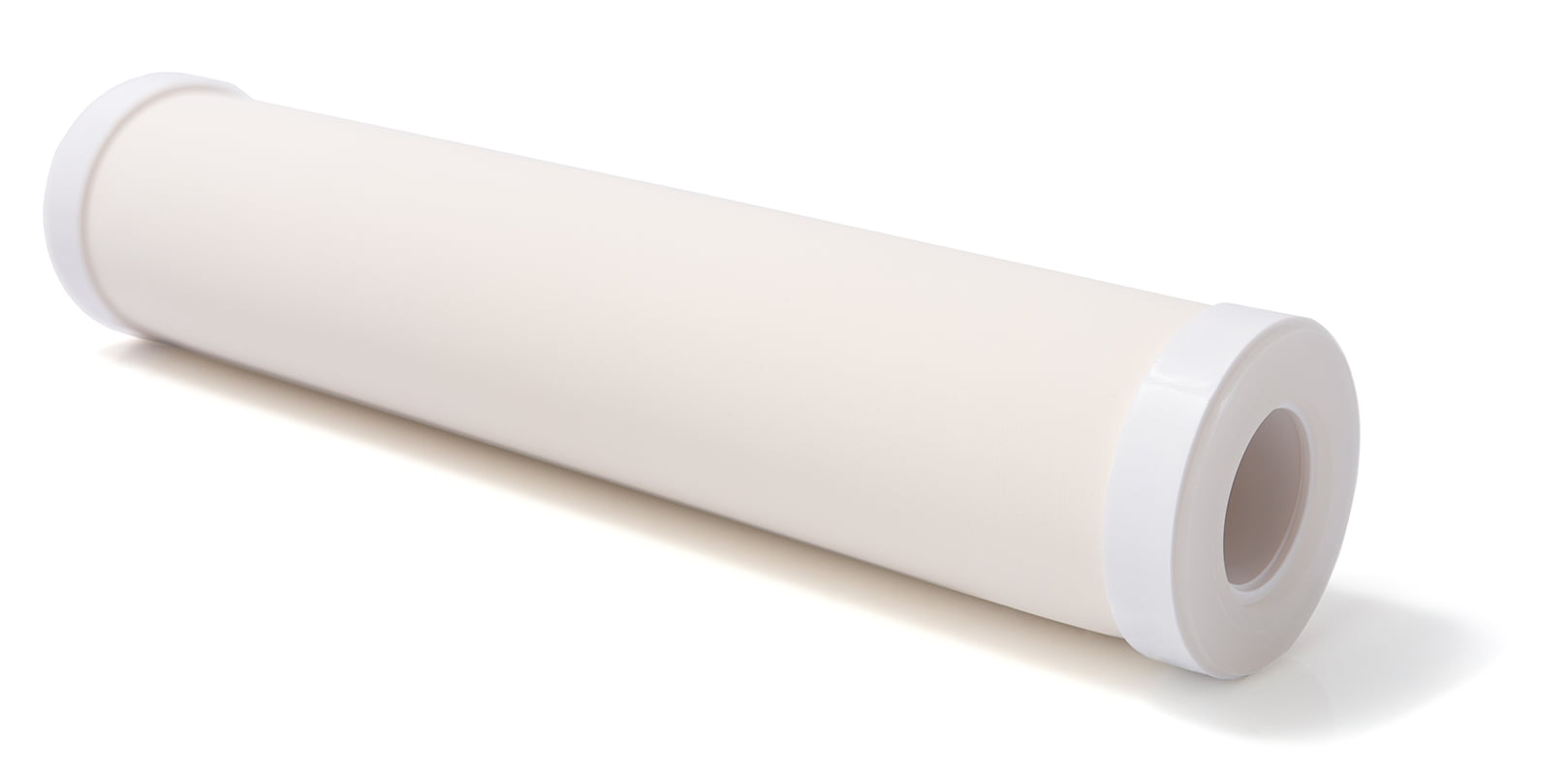Ceramic Water Filter vs Reverse Osmosis System – What’s Better?
Written by: Alexandra Uta // Last Updated: Jun 16, 2023
This page may contain affiliate links. If you buy a product or service through such a link we earn a commission at no extra cost to you. Learn more.
Ceramic water filters can be quite effective at dealing with certain water contaminants. However, if reverse osmosis is supposed to be really powerful.
So which to choose?
Let’s take a look at the differences and similarities between reverse osmosis and ceramic water filtration and find out what’s better.
Key Takeaways
- Both reverse osmosis and ceramic water filter rely on pores to remove contaminants. But RO membranes have much smaller pores (0.0001 microns) than ceramic filters (0.5-50 microns) so they are much more effective.
- Ceramic filters can remove sediments, microorganisms, and other large compounds like asbestos. RO is ideal if you want to target ions such as lead, chromium, or fluoride.
- While RO water treatment is much more powerful at removing harmful contaminants, it slows down water flow considerably, it produces wastewater, and often it’s more costly.
What Is a Reverse Osmosis System and How Does It Work?
A reverse osmosis system relies on a thin semipermeable membrane as its main filtration element. The system is designed so that water is pushed through this membrane at high pressure. The membrane has tiny pores (0.0001 microns in size) and as a result only water molecules can pass through them; everything else gets rejected and left behind.
This method of purifying water is highly effective, although it does come with some minor disadvantages. Most importantly, it produces wastewater.
In addition to the membrane, RO system use pre and post-filters. They add to the overall contaminant reduction and also protect the delicate RO membrane from sediments and chlorine.
And lastly, most reverse osmosis system are under sink or countertop units.
What Is a Ceramic Water Filter and How Does It Work?
A ceramic water filter is a type of sediment filter. It also relies on small pores (about 0.5 to 50 microns in size) scattered around the surface of the filter which capture floating particles and prevent them from making their way into the filtered water supply. This might sound similar to reverse osmosis, but the process is actually quite different.
Also, many ceramic filters come with only the outer shell made of ceramic material. The inner core is often filled with media such as activated carbon or ion exchange resin to remove some of the contaminants that the ceramic filter didn’t catch. Examples are organic chemicals like pesticides or heavy metals including lead.
Ceramic water filters are found in gravity systems, but also under sink and countertop units.
Reverse Osmosis vs Ceramic Filter – Difference
There are various differences in the operation of reverse osmosis systems and ceramic filters. Let’s take a look at the most notable ones.
Filtration Process
The filtration process is vastly different. On the one hand, we have reverse osmosis, which forces water to diffuse through a semipermeable membrane. This doesn’t work on size exclusion alone. Factors such as feed water temperature, pressure, and salinity also play and important role. Plus, pore size is tiny and the nature of the process allows an RO membrane to remove dissolved solids.
Ceramic filters, on the other hand, are more like sieves. They rely on physically blocking suspended contaminants with a porous surface of much larger pore size This is based on nothing but size exclusion. Either a certain impurity or contaminant is large enough to be captured by the filtration matrix or it’ll slip through the net and make it into your drinking water.
Contaminant Removal
Speaking of, ceramic filters can be very thorough in their contaminant removal, but they are still not as good as reverse osmosis membranes. So if you want the best filtration available on the market, you have to go with a reverse osmosis system. It can remove
- 90 to 99% of aluminum, arsenic, cadmium, chromium 6, fluoride, lead, sodium and other ions.
- Radioactive elements
- Pesticides and herbicides
- VOCs
- Microorganisms
- Sediments
- And more
Depending on the pore size, a ceramic water filter may remove suspended solids, such as sediments and even particulate lead, microorganisms, and asbestos.
Flow Rates
Both filtration methods restrict the flow rate of water to some extent. Reverse osmosis is worse in this regard. Due to its restrictive nature, you have to use a storage tank as a temporary buffer or a pressure pump if you want to always have access to filtered water.
Filter Capacity
One great advantage of ceramic filters is that they are easy to clean and reuse, so you don’t need to replace them that often. With reverse osmosis filtration, you have to remember to swap out the membrane every few years. Both systems require relatively little maintenance, but ceramic filtration is arguably better in this regard.
Wastewater
Reverse osmosis produces a lot of wastewater as part of the process. This can’t be avoided, only minimized to some extent. You have to be prepared to deal with a lot of wastage if you want to use reverse osmosis. However, keep in mind that you can still reuse that water for other purposes, and it doesn’t have to be necessarily considered wasted.
Installation and Maintenance
Reverse osmosis systems typically require a little more effort in their installation, but not so much in their maintenance. Once you’ve got the system up and running, you basically only have to remember to replace the filters every now and then.
Of course, the same applies to ceramic filters. But they often have the additional advantage of being easier to set up. This applies to gravity filters in particular.
Dependence on Water Pressure
Water pressure will affect the performance of a ceramic filter in the sense that low pressure might result in a lower flow rate. When it comes to reverse osmosis, however, high pressure is absolutely necessary for the system to operate in the first place. That’s one of the main disadvantages of reverse osmosis systems in most people’s eyes. Without sufficient feed water pressure, the process will be highly wasteful and rather ineffective.
Cost
Ceramic water filters tend to be cheaper than reverse osmosis systems. That’s especially true if you want to go for a point-of-use system. With reverse osmosis, you should set aside more money for the initial purchase.
Pros and Cons of RO Systems
Pros
- Very thorough filtration, removes most types of harmful contaminants
- Relatively little ongoing maintenance required
- Improves smell and taste of water
Cons
- Requires high pressure to run
- Wastes water
- Works very slowly
- Removes some healthy minerals along with contaminants
Pros and Cons of Ceramic Filters
Pros
- Thorough filtration that can deal with many types of contaminants if additional filter media is used
- Improves water aesthetics
- Great in emergency scenarios where you don’t have a pressured water supply (for gravity filters)
- Cheap and widely available
- Easy to maintain
Cons
- Not nearly as thorough as RO
- Manual refilling (for gravity filters)
So, Ceramic Water Filter vs Reverse Osmosis System – Which Is Best for You?
So, RO system vs ceramic filter – which one should you choose?
Between the two, there is no choice that’s universally better. The fact that both systems exist on the market and are popular in their respective circles indicates that they have their individual applications. One of the two might be better for your specific situation, but that is always individual.
Test Your Water Quality
The best way to figure out what you should get is to have your water quality tested. You can do that by submitting a sample of your water to a professional laboratory, which will analyze it and tell you what kinds of contaminants you have and in what concentrations. This is the only way to be sure that you are accurately addressing the specific problems you have.
What Do You Want?
You must also consider how exactly you’re planning to use your new water filter system in the first place. Think about factors like how many people live in your household, how much water you consume on a daily basis, whether you want to filter all of your home’s water or just specific points, and how much you’re prepared to invest in maintaining the system in the long run.
If you have any questions about reverse osmosis vs ceramic water filters please don’t hesitate to leave a comment below!
Information provided on BOS is for educational purposes only. The products and services we review may not be right for your individual circumstances.
We adhere to strict editorial guidelines. Rest assured, the opinions expressed have not been provided, reviewed, or otherwise endorsed by our partners – they are unbiased, independent, and the author’s alone. Our licensed experts fact-check all content for accuracy. It is accurate as of the date posted and to the best of our knowledge.




